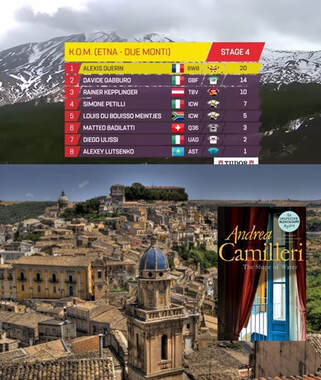
Those seeking public funding for sports events frequently cite the tourism benefits of television coverage. Images of roadside dumping are unlikely to encourage tourism. The hope is that these images will not undo the other captivating images. Earlier in the day the viewers were treated to fabulous images of Mount Etna. There were inviting images of the cyclists climbing and descending with the Mediterranean in the background.
In most cases, the coverage of road cycling races is a form of promotional video. For example, when the race passes some significant building or landscape, captions are placed on the screen and the race commentators turn into tourist guides. The history of the scene is presented. This week the viewer was left in no doubt about the impact of earthquakes and volcanos on the landscape of the island. Occasionally, particularly in the Grand Tours, there will be a discussion of the local food and beverages. Picture postcard stuff. Wish you were here.
Could there have been better planning of yesterday’s stage? Could the local authority not have ensured that a couple of waste collection vehicles travelled the route on the morning of the race? Or could the organisers not have planned to route to avoid potential trouble? Possibly.
The biggest difficulty is that the race, or at least the latter part of it, is broadcast live. It would have been difficult to ensure that the broadcaster avoided unpleasant images. If the locations were known then they could have been cleaned before the event.
Contrast these unpleasant live images with those presented in the Inspector Montalbano TV series. Another potential use of public funds. Here the images are carefully managed and edited. The fictional policeman and his surroundings are a more inviting advert for Sicily than the Andrea Camilleri books on which they are based – although the books present more culinary details than is present in the TV series or the Eurosport coverage. The first book is called The Shape of Water and the blurb on the cover starts with “When the body of a respected and prominent engineer Silvio Luparello is discovered in the Pasture, a rubbish-strewn site brimming with drug dealers and prostitutes, …”. The investigation turns on a detail in a photograph of the dead man. A detail that is spotted by his wife. Something that is out of place. Something that takes from the narrative that the dead man's enemies are trying to present. A bit like a few black bin bags in The Race Across Beauty.
Yet, the books also evoke a feeling for the place that is more likely to encourage than discourage the reader to visit the island. Maybe a few black bin bags are unlikely to do too much damage.
 RSS Feed
RSS Feed